Table of Contents
Vegetarianism and veganism have become increasingly popular of late, for many reasons. Some try to save the lives of animals with this approach, others are interested in the ecological aspect and some simply do not like the taste of meat and animal products. Whatever your interest in plant protein sources is, don’t worry about giving up your favourite steak, egg, or yogurt. However, it is certainly not a bad idea to regularly include plant sources of proteins, which typically do not contain as many saturated fatty acids and will generally enhance your diet. In today’s article, we will explore the reasons why more and more people are interested in plant protein sources, and we will also clarify which are the best.
You will learn about the following foods in the article:
4 reasons to include plant protein sources
People who have chosen to radically reduce animal products usually have a reason to do so. We will zoom in on the four main arguments that may convince you that greater inclusion of plant protein sources makes sense.
1. Ethical viewpoint
People started eating animals 2.5 million years ago, which is one of the reasons why, even nowadays, many people consider eating chicken, beef and other meats to be normal and natural. What has changed, however, is the amount of meat we eat each year as a society and the way we treat animals. Mass breeding, slaughter and the general treatment of animals is increasingly described as unethical, inhumane, and quality is often undermined at the expense of quantity, even as welfare of animals is gradually being taken into account. [1]
Eliminating animal products is one option, but a less radical option may be to start by tracking the origin of the food you buy.
- Wonder where the animals were kept? You can tell by the quality and taste of the meat, or whether the eggs come from hens that have spent their lives in cages or meat from cows that have been free to graze. Equally, the quality of eggs differs from hall laying hens from and free-range.
- Find out what the animals were fed. Their diet affects both the quality of the meat itself and the product, such as milk or eggs.
The optimum solution may be to buy products from BIO or local breeders, where you will know the origin of the food, and you will also support the economy in the region.
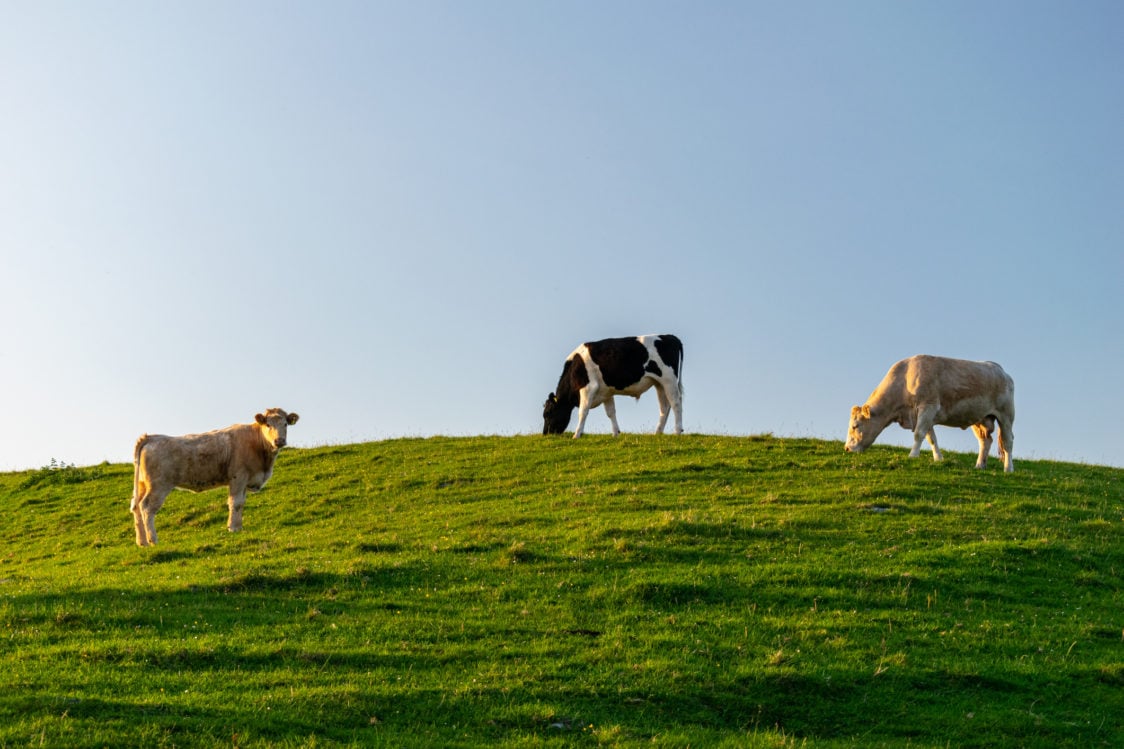
2. Ecological viewpoint
You may not be surprised to learn that the meat industry produces huge amounts of greenhouse gases. High meat production is also one of the main causes of biodiversity reduction and extinction, for example due to the felling of indigenous forests. Unfortunately, this is not the only problem. For example, did you know that 15 500 litres of water is used to produce 1 kg of beef? [2-5]
As far as food production is concerned, meat products also have the highest carbon footprint, i.e. the amount of greenhouse gases produced throughout the cycle of a particular food – from production to processing, transport to disposal of its packaging. The carbon footprint has a negative impact on climate change, air pollution and the like. For comparison, the carbon footprint of 1 kg of beef or sheep meat is around 36 kg of CO2, for legumes or vegan meat substitutes it is 1-5 kg of CO2 at the same amount. And that’s a big difference, don’t you think? You can reduce it just by buying meat from local farmers. Even if the difference isn’t so great, every effort counts. [6-7]
You might be interested in these products:
3. Health viewpoint
According to the results of the studies, vegetarian and vegan diets have a positive effect on lowering BMI, cholesterol or blood sugar. At the same time, statistically significant differences in cancer and cardiovascular mortality rates were also shown in favour of vegetarians and vegans compared to people who consumed meat and other animal products. [8]
But these results, too, need to be treated critically and not to draw conclusions that animal products are the cause of all evil. If we were to compare a person who doesn’t move much and eats fatty meat every day with a vegan who keeps his diet balanced and maintains an active lifestyle, he’d probably be a healthier vegan. However, this is not proof that animal products are harmful. The issue needs to be seen in an overall context, not just individual data taken out of context. If we want to do what’s best for our health, we should focus on a healthy, rational diet. And it’s up to us whether or not meat and animal products are part of it.
The results of the studies may also be due to the fact that if animal products are discarded, your choice of foods you consume will be reduced. Energy density of food can also play a role. When we focus on the calorie content of the same amount of a vegan diet and typical Western diet, we find that the vegan diet is usually less caloric. This can also lead to a more balanced energy intake for vegans, possibly weight loss, with which a reduction in health risks goes hand in hand. After all, there’s a difference between having a banana or a hot dog as a quick snack.
4. Variety
Plant protein sources may not be just a good way to conserve the environment. It is also a great way to enhance your diet and avoid the stereotype of daily chicken with rice. In addition, you will increase your intake of various antioxidants with a plant-based diet. How about a big load of legumes or roasted tofu for lunch once a week instead of roasted meat?
To give you an idea of what sources of protein a plant-based diet offers, we have prepared a practical overview of categories and specific foods for you. Each contains an average macronutrient content and ways to use them in the kitchen.
If you are wondering how much protein you should consume relative to your goal, read the article How to Calculate Energy and Macronutrient Intake for Weight Loss or Muscle Gain?
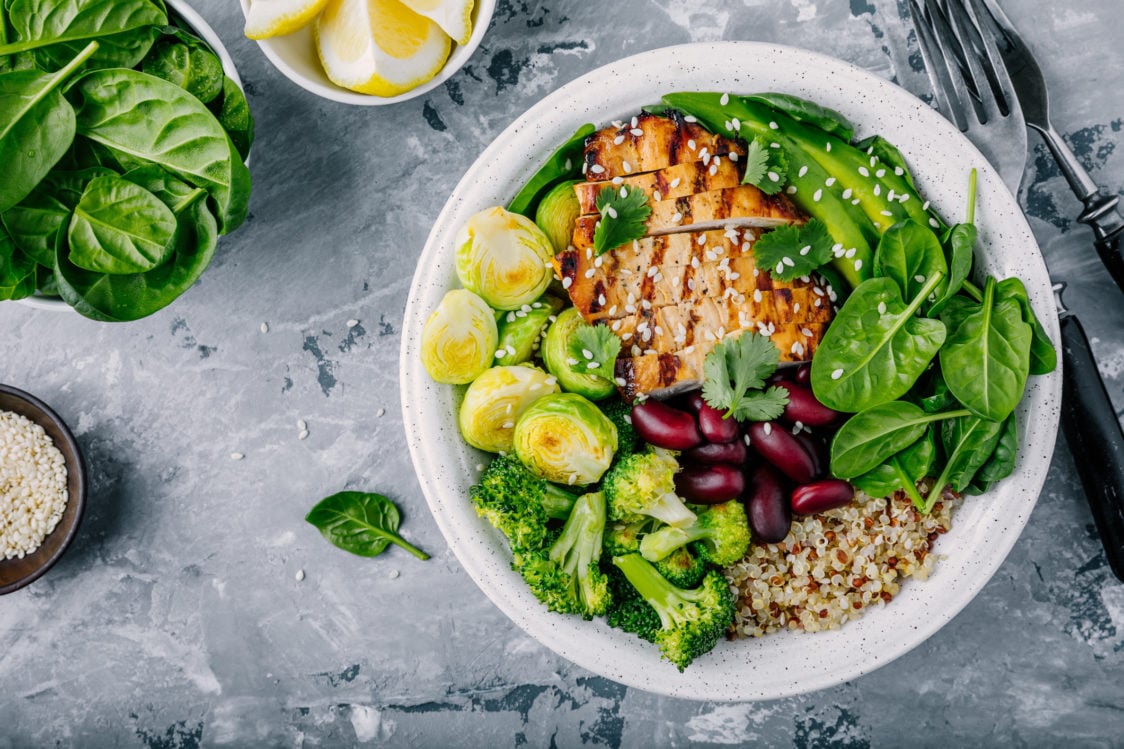
Legumes
Legumes such as lentils, peas, chickpeas and beans are generally considered leguminous vegetables. You may be surprised, however, that we include soya or peanuts. This group of foods is typically rich in complex carbohydrates, proteins, fibre and minerals such as phosphorus or calcium. Conversely, leguminous vegetables usually do not have a high fat content. Thanks to the combination of fibre and protein they have a high satiating effect, which is ideal especially for people who want to lose weight. However, leguminous vegetables have a less favourable amino acid spectrum (for example, due to low methionine – the so-called limit amino acid) and thus it is recommended to supplement them with additional sources of protein. Cereals, for example, or nuts and seeds, which are rich in this limit amino acid, can serve this purpose perfectly.
The advantage of leguminous vegetables is that they are gluten-free, so people who have a problem digesting gluten need not fear their consumption. [9]
1. Red lentils
Lentils, and not just red, can be considered a great source of plant proteins and complex carbohydrates. Due to their low glycaemic index, its addition to food has a positive effect on blood sugar levels, which is confirmed by the results of studies. In addition, it can also help reduce “bad” LDL and increase “good” HDL. [10–12]
What is the average nutritional value of 100g of raw peeled red lentils?
- 362 kcal, 55g carbohydrates, 27g protein, 2.6g fats
How to incorporate lentils into your diet?
Peeled red lentils have one major advantage – they do not need to be soaked before cooking because they do not contain peel. Long preparation and several hours of soaking is also a common reason why people avoid legumes. It would be a great pity not to include red lentils in your diet because besides valuable nutrients, you would also be deprived of their excellent taste. This will stand out best if you eat them as a separate dish. However, they also taste perfect in salads, sauces, vegetable pancakes, bowls or soups. They are cooked in 20 minutes, so are no more complicated to prepare than rice. You can even cook them in a rice cooker, making the process even easier.
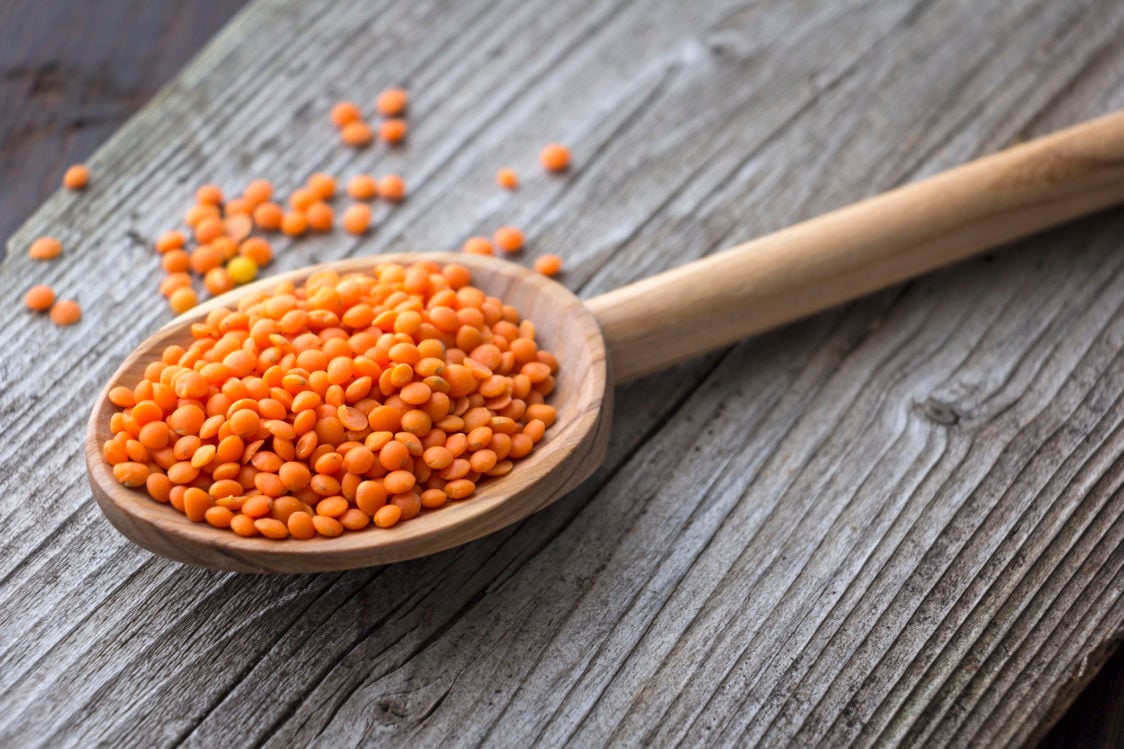
2. Chickpeas
In addition to its protein and fibre content, chickpeas also boast a higher proportion of folic acid, manganese, copper or iron. As one of the few leguminous plants, it has a very favourable composition of essential amino acids, making it a highly valued source of protein not only among vegans. This is probably why chickpea protein is becoming increasingly popular. Chickpeas have a low glycaemic index which has a positive effect on blood sugar levels. And like lentils, they can also positively affect cholesterol levels. [13-14]
What is the average nutritional value of 100g of raw chickpeas?
- 336 kcal, 44g carbohydrates, 19g protein, 6g fat, 15g fibre
How to incorporate chickpeas into your diet?
You don’t have to at all costs just make delicious hummus out of chickpeas. They are also great for salad or as a healthy TV snack. It is enough to lightly dip chickpeas in oil, season them, bake till golden and delicious and crunchy. Chickpeas can also be used in the preparation of sweet desserts, which will be enriched with valuable nutrients and proteins. If you do not want to spend any extra time in the kitchen, it is recommended to have already cooked chickpeas in brine at home, which are intended for immediate consumption.
3. Mungo beans
Mungo beans are distinguished by their high content of essential amino acids, making them a high-quality source of protein from the plant kingdom. They are also rich in antioxidants, vitamin B9, and valuable minerals such as magnesium, phosphorus, iron, and copper. [15]
Do you know what the best thing about mungo beans is? That you can let them germinate at home yourself and enjoy the final product all the more. In addition, this process will reduce the content of antinutrients, thanks to which mungo beans are better digestible and nutrients from them are better absorbed.
What is the average nutritional value of 100g of raw unsprouted mungo beans?
- 347 kcal, 63g carbohydrates, 24g protein, 1.2g fat, 16g fibre
How to incorporate mungo beans into your diet?
Mungo beans are an integral part of Vietnamese salad Bún bò nam bộ. However, they are also great in Czech salads or as a filling for tortillas. Since the sprouts taste similar to freshly peeled peas, you can eat them on their own.
However, these three leguminous vegetables are not the only source of protein with which you can enrich your diet. A great choice is also peas, which also contain approximately 23g of protein per 100g. Leguminous products can also be an excellent alternative. How about trying protein chips made from lentil flour or legume pasta?
Among leguminous vegetables, legumes also have a high protein content (26 g in 100 g). However, they also have a high fat content to think about, so you should not overdo it.
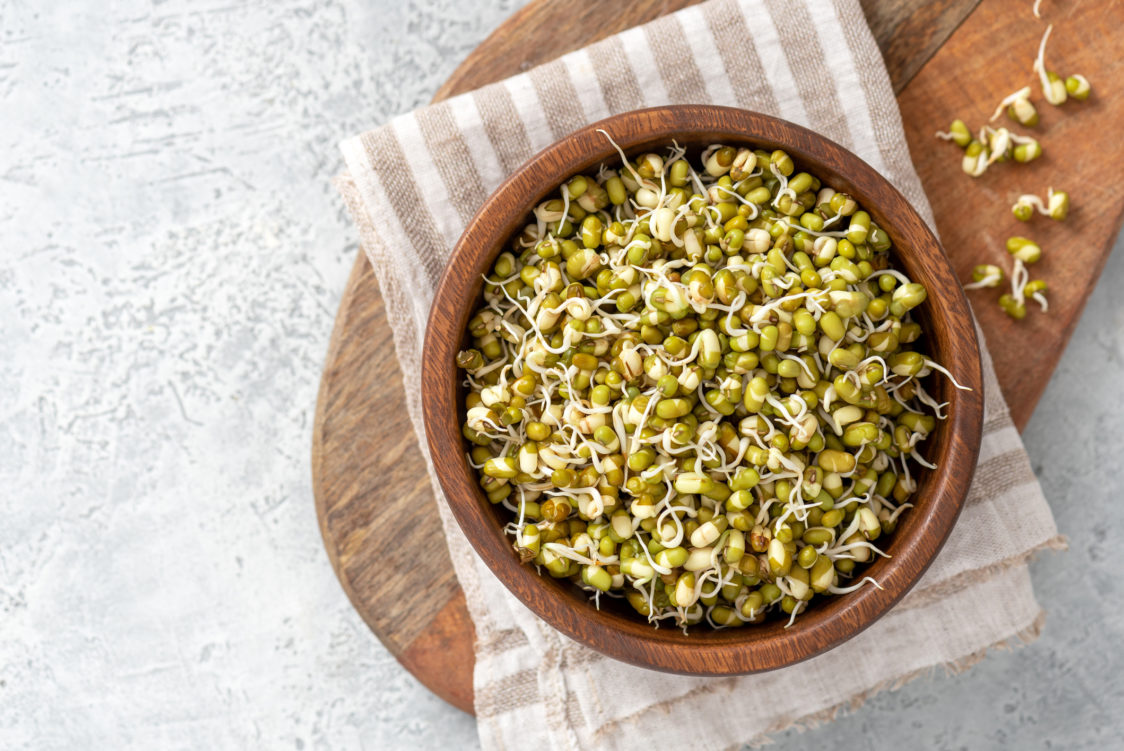
Vegetable meat substitutes
As the name suggests, substitutes are most often used in recipes instead of the meat itself. They can be made from, soya or wheat flour, for example.
1. Tofu
Tofu is a soya product that varies in structure, consistency and taste depending on the type. It is distinguished by its high–quality protein, calcium and low sodium content. Tofu is made from soya beans. They are first rinsed, allowed to swell in water, and then mixed together into mush. This is cooked at more than 100 °C, thus eliminating the soya aftertaste. Next, the mash is strained to create a soy drink. It is then allowed to precipitate to form the resulting tofu. [16] [38]
What is the average nutritional value of 100g of tofu?
- 125 kcal, 2.3g carbohydrates, 12g protein, 7.5g fat
How to incorporate tofu into your diet?
Tofu can be used in the kitchen in the same way as classic meat. It is such a great part of sauces or salad. The great advantage is that it can be cooked and eaten both warm and cold. For example, cut it into thinner slices and replace it with ham or cheese for pastries. If you get flavourless tofu, you can mix it with frozen fruit to make a creamy vegan ice cream.
2. Tempeh
Tempeh is a fermented product that is made from boiled, mashed and pressed soybeans to which bacterial cultures are added. Tempeh is valued for its high content of easily digestible proteins, calcium, phosphorus, iron, and even vitamin B12, whose sufficient intake can be problematic for vegans. [16]
What is the average nutritional value of 100g tempeh?
- 143 kcal, 3.8g carbohydrates, 16.7g protein, 8.3g fat – these values can vary by tens of calories depending on the flavour and marinade
How to incorporate tempeh into your diet?
You can also use tempeh in the kitchen in the same way as tofu. It tastes great with bulgur, couscous and can substitute minced meat.
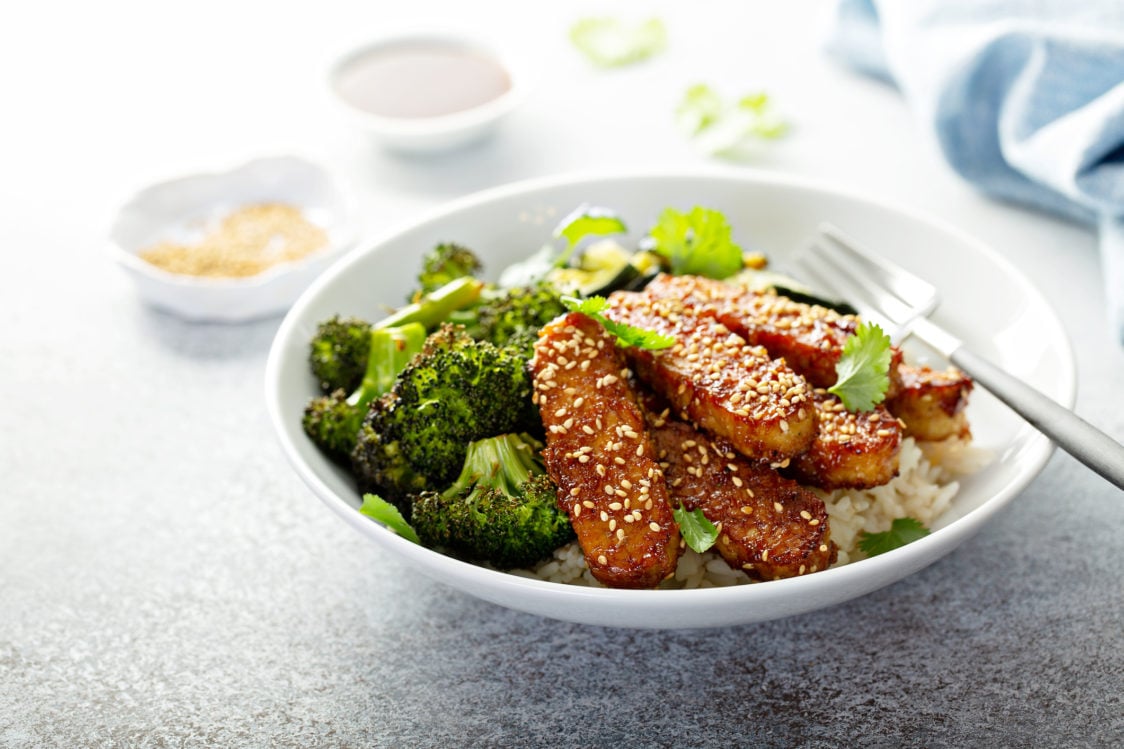
3. Seitan
Seitan is a plant protein that you may know as wheat gluten. You can even make it yourself at home by rinsing flour repeatedly. However, it is still low in carbohydrates. If you don’t want to make it, it can be purchased as a powder that you mix with water or as a finished product.
What is the average nutritional value of 100g of seitan?
- 104 kcal, 3.5g carbohydrates, 21g protein, 0.5g fat
How to incorporate seitan into your diet?
Perhaps unsurprisingly, you can use it the same as tofu or tempeh. It is also quite popular to incorporate seitan into a burger instead of meat. But you must not forget to season it well.
Nuts
Nuts and nut butter can certainly boast high levels of healthy fats. But did you know that they usually excel in their proportion of protein or fibre? Do not try to use them as a primary source of proteins. Given their higher calorie value, it would certainly affect your physique over time, not to mention the fact that you might experience unpleasant digestive problems.
1. Almonds
Almonds boast vitamin E, manganese, magnesium and antioxidants to help protect cells from oxidative stress. This could contribute to the development of inflammation, ageing or cancer. In addition, they also have a positive effect on optimizing blood sugar levels and pressure. [17-20]
What is the average nutritional value of 100g almonds?
- 575 kcal, 22g carbohydrates, 21g protein, 49g fat, 12g fibre
How to incorporate almonds into your diet?
Almonds are a great addition to porridge, desserts, both directly in the form of nuts and slivers, almond butter or almond flour. However, they can also function as a crunchy component in a salad or as a separate healthy TV snack.
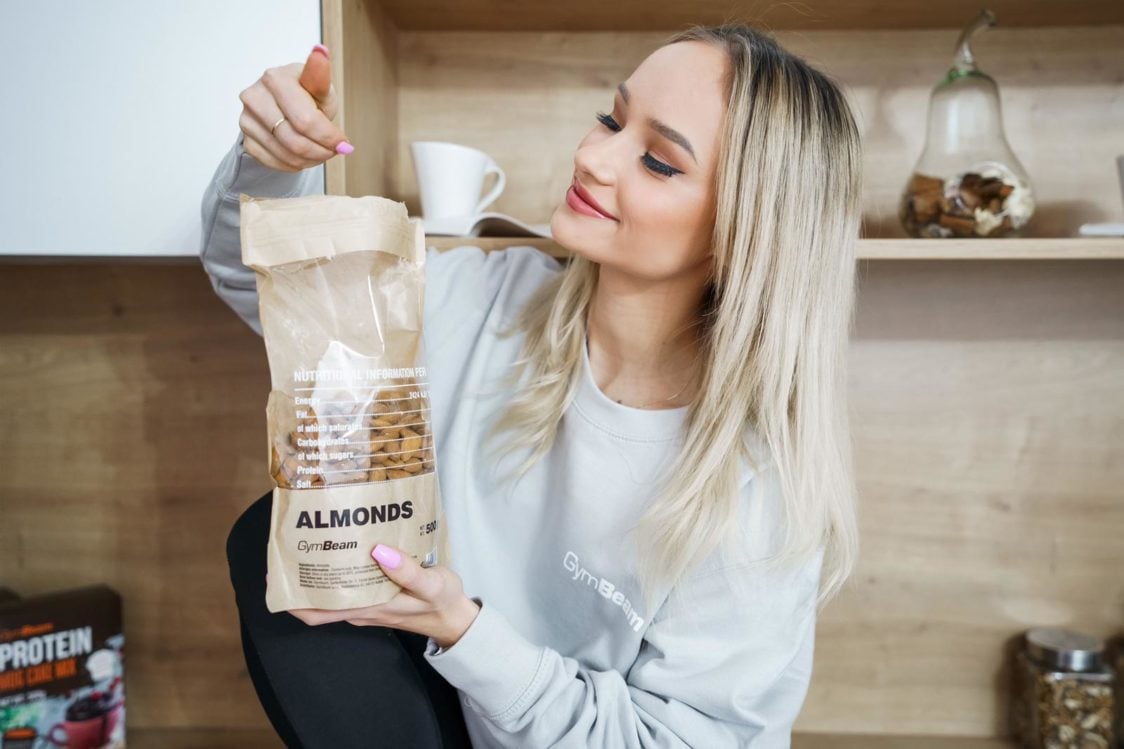
2. Pistachios
Pistachios are known for their healthy fat content in the form of unsaturated fatty acids, copper, vitamin B6 and B1. Among other nuts, they are distinguished by their higher proportion of amino acids. They also have a decent level of antioxidants and a positive effect on cholesterol levels. [21-22]
What is the average nutritional value of 100g of pistachios?
- 564 kcal, 29g carbohydrates, 21g protein, 43g fat
How to incorporate pistachios into your diet?
Pistachios taste great on their own, as part of desserts, salads or porridge, even in the form of pistachio butter.
3. Cashews
Cashew nuts stand out not only for their delicious taste, content of copper, magnesium, manganese, phosphorus or iron. They are rich in unsaturated fats that can reduce the risk of heart disease. Their composition also contains important antioxidants. [23]
What is the average nutritional value of 100g of cashews?
- 553 kcal, 30g carbohydrates, 18g protein, 44g fat
How to incorporate cashews into your diet?
Cashew nuts taste great on their own, as part of desserts, salads or porridge. You can also use them to prepare a delicious sauce.
In addition to the above-mentioned nuts, however, it is definitely worth mentioning, hazelnuts and walnuts, which also boast a high content of beneficial substances and have a delicious taste.

Seeds
Various types of seeds are among the nutrient-laden foods that are perfectly smuggled into just about every meal. As a result, it usually supplements not only the necessary micronutrients, but also proteins, healthy fats and fibre.
1. Hemp seeds
Hemp seeds stand out for their delicate nutty taste and excellent composition. In addition to protein, they are high in vitamin E, phosphorus, potassium, magnesium, sulphur, calcium and iron. They help to reduce the risk of heart disease and PMS, mainly due to the gamma-linolenic acid content, which reduces the effects of prolactin causing PMS. They also work well for those with digestive problems. [24-25]
What is the average nutritional value of 100g of hemp seed?
- 600 kcal, 5g carbohydrates, 31g protein, 48g fat, 8g fibre
How to incorporate hemp seed into your diet?
Thanks to their nutty taste, they are perfectly suited to both sweet and salty dishes. You can add them to your porridge, yogurt, crème or salad.
2. Chia seeds
The popularity of chia seeds has increased in recent years. Some might think this is a new ingredient, but the opposite is true. Chia seeds were already on the Aztec and Mayan menus. They stand out for their calcium, manganese, magnesium or phosphorus content and are loaded with antioxidants and omega-3 fatty acids. Again, they can have a positive effect on cholesterol and blood sugar levels. [26-29]
What is the average nutritional value of 100g of chia seed?
- 486 kcal, 35g carbohydrates, 19g protein, 31g fat, 35g fibre
How to incorporate chia seeds into your diet?
Chia seeds can be sprinkled into salad, porridge, mixed into sauces and other mixtures or made into a delicious chia pudding. Among vegans, these seeds are often used as a substitute for eggs. When mixed with water, they form a gel that superbly substitutes egg with its consistency in recipes.
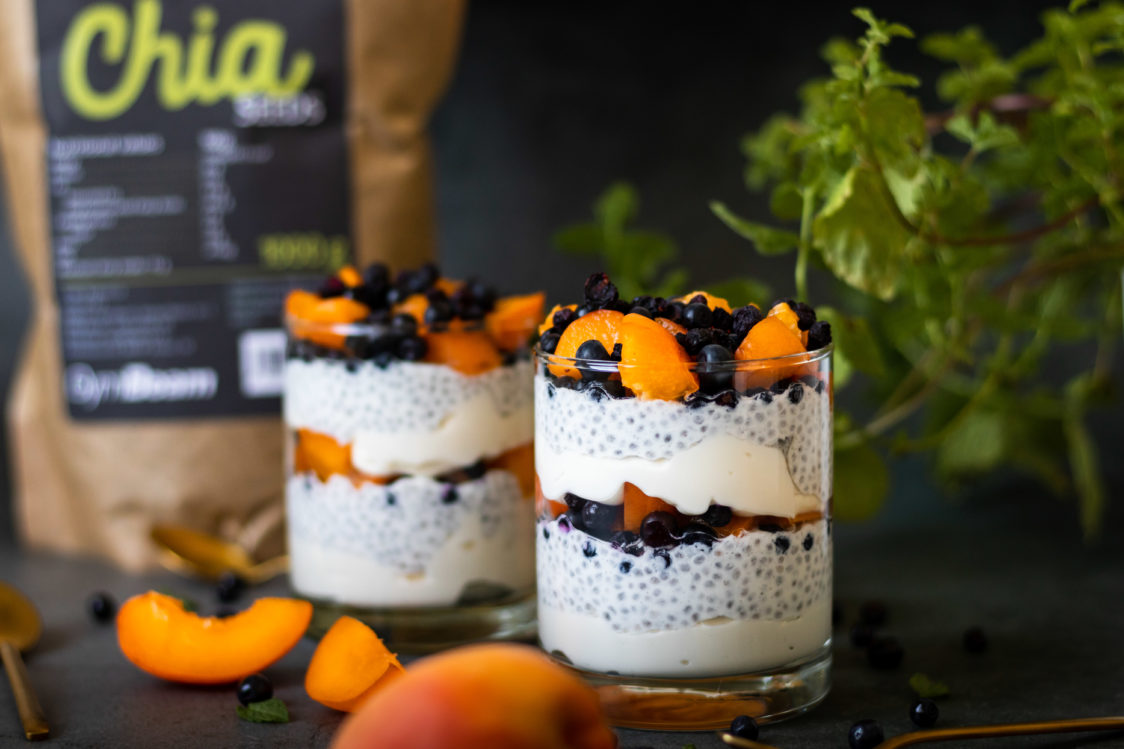
3. Pumpkin seeds
Pumpkin seeds have high levels of phosphorus, manganese, magnesium, iron, zinc or copper in addition to protein, healthy fats and fibre. They are rich in antioxidants and may have an effect on reducing the risk of developing lung, breast, stomach or colon cancer. In addition, they help to improve the health of the prostate and bladder. [30-32]
What is the average nutritional value of 100g of pumpkin seed?
- 559 kcal, 11g carbohydrates, 30g protein, 49g fat, 6g fibre
How to incorporate pumpkin seed into your diet?
Pumpkin seeds stand out perfectly in any vegetable salad or porridge. If you bake your own bread or buns, try sprinkling pumpkin seeds on top. You’ll love their taste.
It is worth mentioning flax or sunflower seeds, which also have high protein and other nutrient content.
Pseudo-proteins and other sources
This category includes gluten-free pseudo cereals, which are rich in protein in addition to carbohydrates. However, we must also mention nutritional yeast, which is very popular among vegans.
1. Quinoa
Quinoa is a gluten-free pseudo -cereal, which you probably use primarily as a source of carbohydrates, and so you may not even have known that it has a decent protein content. In its composition you will also find a high amount of healthy flavonoids called Quercetin and Kaempferol. Quinoa has a low glycaemic index and high magnesium, potassium, zinc and iron content. It also excels in its spectrum of essential amino acids. [33]
What is the average nutritional value of 100g of quinoa?
- 354 kcal, 64g carbohydrates, 14g protein, 6g fat
How to incorporate quinoa into your diet?
Quinoa, which you should not forget to rinse with water before preparation, is used primarily as an adjunct to sauces, meat or its substitutes. However, you can also add it to salads, increasing its protein and complex carbohydrate content. It also tastes great in various vegetable patties, in which it also helps to create optimal consistency.
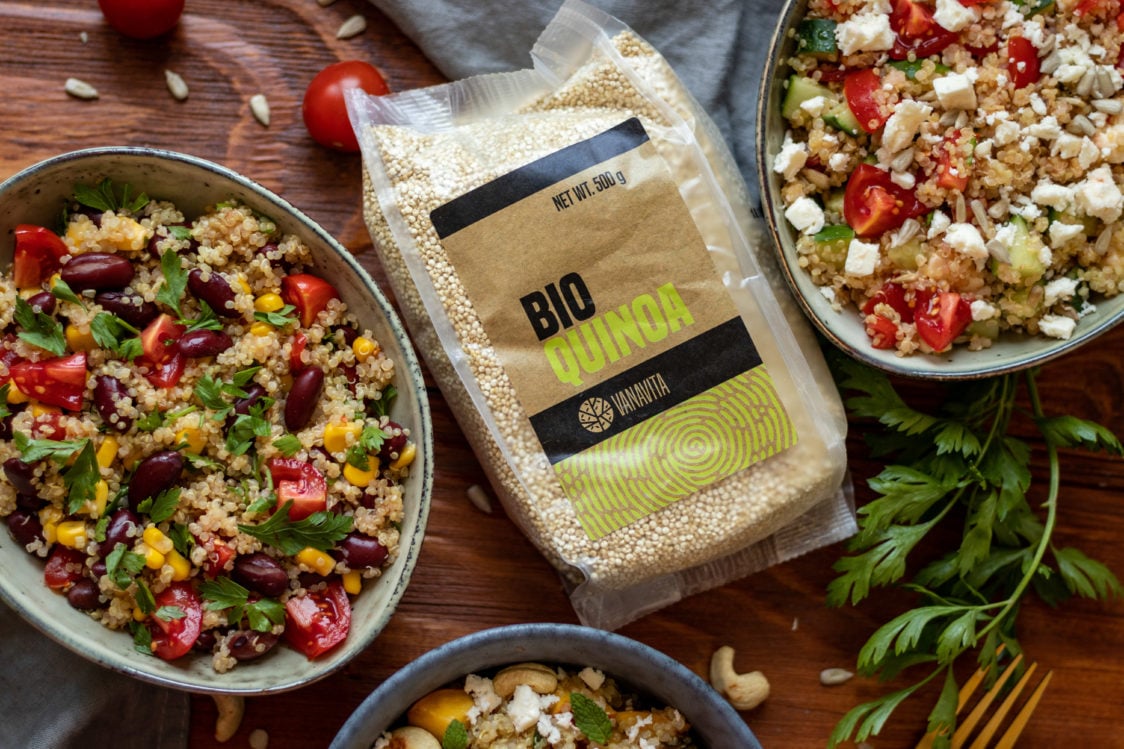
2. Amaranth
We can also classify amaranth as a gluten-free pseudo cereal with a positive effect on our health. It is high in manganese, magnesium, phosphorus and iron. It also excels in its representation of essential amino acids. In the body, it can help to reduce inflammation and cholesterol levels. [34-36]
What is the average nutritional value of 100g of raw amaranth?
- 371 kcal, 65g carbohydrates, 14g protein, 7g fat
How to incorporate amaranth into your diet?
Amaranth, like quinoa, can be used as a side dish, in salads or other mixtures. You can also use it to make porridge or thicken the soup or sauce.
3. Nutritional yeast
Nutritional yeasts are gluten-free inactive yeasts in the form of small flakes that resemble Parmesan in their taste and smell. In addition to protein, they are high in amino acids and other nutrients. Yeast is generally considered a great source of vitamin B. [37]
What is the average nutritional value of 100g of nutritional yeast?
- 327 kcal, 9g carbohydrates, 49g protein, 5g fat, 27g fibre
How to incorporate nutritional yeast into your diet?
Due to its similarity to cheese, it is perfect for pasta, sauces, soups, spreads or as a salad seasoning. Combined with crushed tofu, it tastes similar to scrambled eggs.
Vegan proteins
In the last category we will focus on dietary supplements, which can greatly ease your intake of plant proteins, and thus are plant proteins and their products. Since single source plant proteins generally lack at least one essential amino acid, it is advisable to choose those consisting of a combination of several sources. An example is BIO Vegan Protein, which is composed of pea, rice and hemp protein. However, an exception may be the soy protein, which is most similar in its representation of individual amino acids to the animal protein.
Among the most well known types of plant proteins we include:
- pea protein
- hemp protein
- rice protein
- soy protein
- chia protein
- pumpkin protein
How to incorporate protein into your diet?
All you have to do is mix it with water, milk (vegans with vegetable) and simply drink it. However, it can be added at any time to smoothies, desserts, porridges or yoghurts to increase the protein content. If you include it after training, you also speed up the regeneration process.
In addition to proteins, however, you can also enjoy other products such as vegan protein bars and protein chips.
What should you remember?
There are plenty of ways to get protein into your body from plant sources. So, no one can tell you that being a vegetarian or a vegan is boring. If you choose a plant-based diet for any reason, try to make your diet as varied as possible and cover your intake of all important vitamins and minerals. It is not only vegans who may find it problematic to have enough vitamin B12, so supplementation should be considered if necessary. However, if you eat good food and keep an eye on all the macronutrients and micronutrients, you can probably do without animal products. Moreover, you will then live with the positive feeling that you are saving the lives of animals and our planet.
If you can’t imagine life without animal products yet, at least try swapping them for plant products once in a while. You will see that you will like the new possibilities offered by these ingredients. For example, take inspiration from the international Meat Free Monday campaign and be meat free on Mondays.
How are you doing with your protein intake – drawing primarily from plant sources, or building your diet on meat, eggs and dairy products? Share your opinion with us in the comments and you can also throw in tips on your favourite plant protein sources.
[1] Christopher A. Monteiro a kol. – Carnism Inventory: Measuring the ideology of eating animals – https://doi.org/10.1016/j.appet.2017.02.011
[2] Henning Steinfeld a kol. – Livestocks long shadow: Environmental issues and options – https://www.europarl.europa.eu/climatechange/doc/FAO%20report%20executive%20summary.pdf
[3] Mark Williams a kol. – The Anthropocene biosphere – https://journals.sagepub.com/doi/10.1177/2053019615591020
[4] Water footprint network – https://www.waterfootprint.org/en/
[5] Pierre J Gerber a kol. – Environmental impacts of beef production: Review of challenges and perspectives for durability – https://pubmed.ncbi.nlm.nih.gov/26117397/
[6] Uhlíková stopa potravin – proč se o ni zajímat? – https://udrzitelnyzivot.cz/uhlikova-stopa-potravin-proc-se-o-ni-zajimat/
[7] Elin Röös a kol. – Can carbon footprint serve as an indicator of the environmental impact of meat production? – https://doi.org/10.1016/j.ecolind.2012.08.004
[8] Monica Dinu a kol. – Vegetarian, vegan diets and multiple health outcomes: A systematic review with meta-analysis of observational studies – https://doi.org/10.1080/10408398.2016.1138447
[9] Stefanie Havemeier a kol., Dietary guidance for pulses: the challenge and opportunity to be part of both the vegetable and protein food groups – https://doi.org/10.1111/nyas.13308
[10] Nerea Becerra-Tomás a kol. – Legume consumption is inversely associated with type 2 diabetes incidence in adults: A prospective assessment from the PREDIMED study – https://pubmed.ncbi.nlm.nih.gov/28392166/
[11] H C Lin a kol. – Sustained slowing effect of lentils on gastric emptying of solids in humans and dogs – https://pubmed.ncbi.nlm.nih.gov/1537516/
[12] Zahra Aslani a kol. – Lentil Sprouts Effect On Serum Lipids of Overweight and Obese Patients with Type 2 Diabetes – https://pubmed.ncbi.nlm.nih.gov/26634200/
[13] Livia S A Augustin – Post-prandial glucose and insulin responses of hummus alone or combined with a carbohydrate food: a dose-response study – https://pubmed.ncbi.nlm.nih.gov/26818604/
[14] Jane K Pittaway – Effects of a controlled diet supplemented with chickpeas on serum lipids, glucose tolerance, satiety and bowel function – https://pubmed.ncbi.nlm.nih.gov/17906185/
[15] A.E.Mubarak – Nutritional composition and antinutritional factors of mung bean seeds (Phaseolus aureus) as affected by some home traditional processes – https://doi.org/10.1016/j.foodchem.2004.01.007
[16] Bezpečnost potravin – Jak poznáme kvalitu? – https://www.bezpecnostpotravin.cz/UserFiles/Koubova%201/soja_final_web3.pdf
[17] Nutrition data – https://nutritiondata.self.com/facts/nut-and-seed-products/3085/2
[18] B N Ames a kol. – Oxidants, antioxidants, and the degenerative diseases of aging. – https://www.ncbi.nlm.nih.gov/pmc/articles/PMC47258/
[19] S Lee a kol. – Effects of oral magnesium supplementation on insulin sensitivity and blood pressure in normo-magnesemic nondiabetic overweight Korean adults – https://pubmed.ncbi.nlm.nih.gov/19359148/
[20] M de Lordes Lima a kol. – The effect of magnesium supplementation in increasing doses on the control of type 2 diabetes – https://pubmed.ncbi.nlm.nih.gov/9589224/
[21] M Bulló – Nutrition attributes and health effects of pistachio nuts – https://pubmed.ncbi.nlm.nih.gov/26148925/
[22] Sarah K Gebauer – Effects of pistachios on cardiovascular disease risk factors and potential mechanisms of action: a dose-response study – https://pubmed.ncbi.nlm.nih.gov/18779280/
[23] P M Clifton – A systematic review of the effect of dietary saturated and polyunsaturated fat on heart disease – https://pubmed.ncbi.nlm.nih.gov/29174025/
[24] Cheng-Sue Chang – Gamma-linolenic acid inhibits inflammatory responses by regulating NF-kappaB and AP-1 activation in lipopolysaccharide-induced RAW 264.7 macrophages – https://pubmed.ncbi.nlm.nih.gov/19842026/
[25] ACOG committee opinion. Premenstrual syndrome. – https://pubmed.ncbi.nlm.nih.gov/7556868/
[26] Nutrition data – https://nutritiondata.self.com/facts/nut-and-seed-products/3061/2
[27] Oliviert Martínez-Cruz a kol. – Phytochemical profile and nutraceutical potential of chia seeds (Salvia hispanica L.) by ultra high performance liquid chromatography – https://pubmed.ncbi.nlm.nih.gov/24811150/
[28] Ricardo Ayerza Jr a kol. – Effect of dietary alpha-linolenic fatty acid derived from chia when fed as ground seed, whole seed and oil on lipid content and fatty acid composition of rat plasma – https://pubmed.ncbi.nlm.nih.gov/17356263/
[29] Janet K Snell-Bergeon, R Paul Wadwa – Hypoglycemia, diabetes, and cardiovascular disease – https://pubmed.ncbi.nlm.nih.gov/22650225/
[30] Nutrition data – https://nutritiondata.self.com/facts/nut-and-seed-products/3066/2
[31] Marianna N.Xanthopoulou a kol. – Antioxidant and lipoxygenase inhibitory activities of pumpkin seed extracts – https://www.sciencedirect.com/science/article/abs/pii/S0963996909000453
[32] Heeok Hong, Chun-Soo Kim, Sungho Maeng – Effects of pumpkin seed oil and saw palmetto oil in Korean men with symptomatic benign prostatic hyperplasia – https://pubmed.ncbi.nlm.nih.gov/20098586/
[33] Nutrition data – http://nutritiondata.self.com/facts/cereal-grains-and-pasta/10352/2
[34] Alvin Berger a kol. – Cholesterol-lowering properties of amaranth grain and oil in hamsters – https://pubmed.ncbi.nlm.nih.gov/12690910/
[35] Alvaro Montoya-Rodríguez – Extrusion improved the anti-inflammatory effect of amaranth (Amaranthus hypochondriacus) hydrolysates in LPS-induced human THP-1 macrophage-like and mouse RAW 264.7 macrophages by preventing activation of NF-κB signaling – https://pubmed.ncbi.nlm.nih.gov/24431078/
[36] Nutrition data – https://nutritiondata.self.com/facts/cereal-grains-and-pasta/10640/2
[37] M S Donaldson – Metabolic vitamin B12 status on a mostly raw vegan diet with follow-up using tablets, nutritional yeast, or probiotic supplements – https://pubmed.ncbi.nlm.nih.gov/11146329/
[38] Jak se vyrábí TOFU? – http://patifu.cz/jak-se-vyrabi-tofu/
[39] The carbon footprint of foods: are differences explained by the impacts of methane? – https://ourworldindata.org/carbon-footprint-food-methane

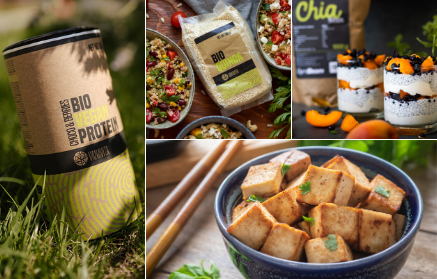
Add a comment